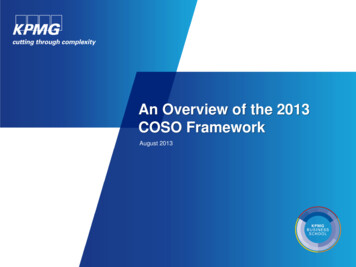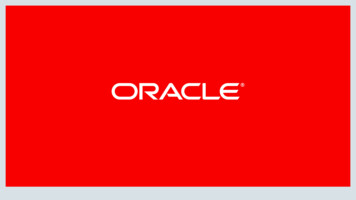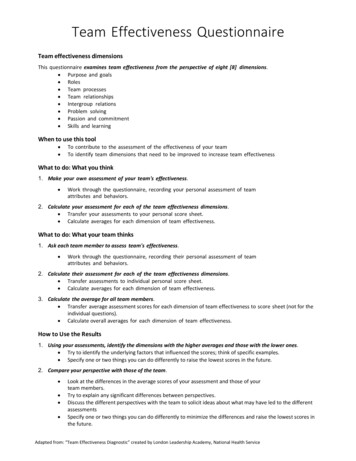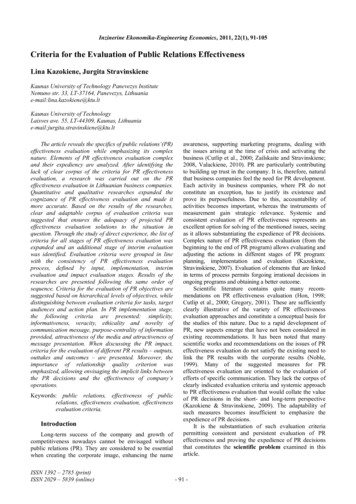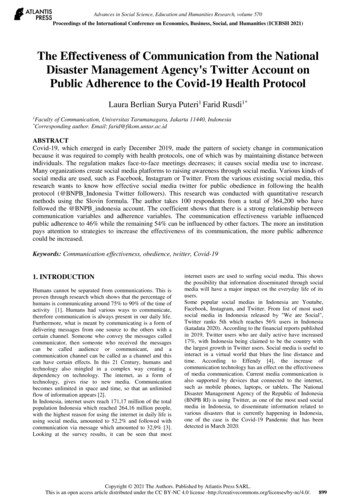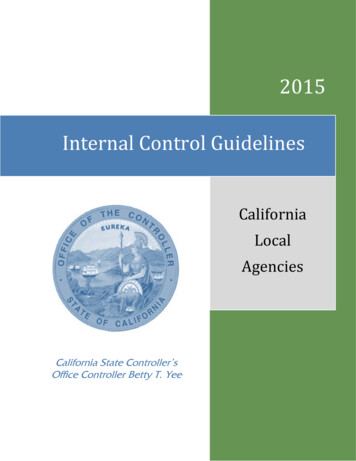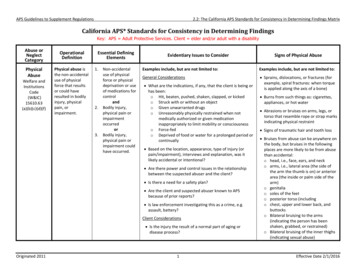
Transcription
International Conference on Accounting, Business, Economics and PoliticsISBN: 978-9922-9036-3-7Determining the Effectiveness of Internal Controls in Enterprise RiskManagement Based on COSO RecommendationsThabit H. Thabit1Department of Computer Engineering and Information, College of Electronic Engineering, NinevahUniversity, Mosul, IraqEmail: thabit.acc@gmail.comAlan Solaimanzadah2Department of Accounting, College of Administrative and Financial Sciences, Cihan University,Erbil, IraqMohammed A. Mohammed3Department of Information System, College of Administration and Economic, Universityof Mosul, Mosul, IraqDOI: 10.23918/ICABEP2019p43Abstract:The continuous risk assessment depends on the integration of the lines of defense (LOD), themain LOD are three lines (management control, risk and control monitoring, ensuringindependence of the internal audit) which lead to the integration of enterprise riskmanagement ERM. The cooperation among the LOD is not new in an environment ofgrowing risk and limited resources. But for this collaboration to be effective, internal controlbodies need to identify a methodology for evaluating the LOD and mitigating the challengesthey face. This study aims to identify the most important internal control methods inassessing the risks facing the organization in accordance with the internal control frameworkissued by COSO in order to limit the obstacles that decrease the ability of the internal auditto rely on others for fear of low level of independence and objectivity, and to clarify theobjectives and motives of internal control and its capability with the responsibility andauthority of the internal auditor within the organization. The main problem of the study isthe ability of internal control to regulate the activity of the organization's LOD in order toincrease the effectiveness of ERM, reduce the cost of compliance and enhance theindependence of the internal auditor of the organization. The researchers adopted COSOrecommendations to determine the effectiveness of internal control in risk assessment of theorganization by analyzing these recommendations and comparing them with the mostimportant challenges facing internal auditing according to the related PwC reports of. Theresearchers concluded that the internal audit plays a major role in improving ERM of theorganization and the integration of its LOD by enhancing the role of the internal auditor andraising the level of its independence and objectivity.Keywords: Internal Control, Enterprise Risk Management, Internal Audit, COSOFrameworkIntroductionInternal control is one of the most important components of ERM in the organization. So,COSO focused on this component and released many papers, frameworks, and reports incooperation with PwC to enhance the effectiveness of internal control in organization. Manyresearchers and scholars have also presented papers on how to develop internal control andhow to strengthen the LOD in the organization by employing internal control in theintegration of LOD. Effective implementation of internal control in the organization can helpto increase the level of compliance and enhance the independence of the internal auditor.381icabep@ishik.edu.iqICABEP2019
International Conference on Accounting, Business, Economics and PoliticsISBN: 978-9922-9036-3-7Research MethodologyThe Study ProblemThe Integration of (management control, risk monitoring and control, and ensuring theindependence of the internal audit function) leads to enhanced ERM in the organization, andthis cooperation is very important in an environment with growing risks and limitedresources. In order for such cooperation to be effective, a methodology should be identifiedto evaluate the integration. So, based on the above, the study problem can be summarized inthe following questions:Do COSO recommendations and the related reports of PwC impact on the effectiveness of internalcontrol in ERM?Does internal control help to enhance the integration of LOD?Does the integration of LOD lead to effective ERM?The Study ImportanceThe research derives its importance from the significance role of internal control inevaluating the risks facing the organization and the positive impact of the recommendationsof COSO framework and related PwC reports in enhancing the effectiveness of internalcontrol and reducing the most important challenges facing the internal auditors in theorganization.The Study ObjectivesThe study aims to achieve the following objectives:Present an introduction about COSO and its frameworks and clarify the most important ERMrecommendations of COSO and related PwC reports.Explain the concept of ERM and LOD in the organization and clarify the main ways of adopting themand reducing their negative effects.Clarify the positive role of internal control in applying the effective ERM in the organization.The Study HypothesesBasically, the study is based on the following hypotheses:H1: Internal control has a positive impact on the integration of LOD of the organization.H2: The COSO recommendations and related PwC reports positively affect the effectiveness ofinternal control in the organization.H3: ERM in the organization is directly affected by the functions of internal control function.Theoretical FrameworkEnterprises Risk Management:The enterprises risk management can be defined as” an operation, implemented by anorganization's board of directors, administration and other individuals , used in strategysetting and within the organization, intended to recognize possible events that may impacton the organization, and treat risk to be within its risk appetite, to supply acceptableconfirmation for achieving the organization aims”[1].The Three LOD in Effective Risk Management and Control:382icabep@ishik.edu.iqICABEP2019
International Conference on Accounting, Business, Economics and PoliticsISBN: 978-9922-9036-3-7The LOD was formed as a result of the global financial crisis to supply a coherent andarranged approach to risk and assurance by organizing main functions and duties into threelines of defense [2].The LOD has been generally accepted framework in industry to manage organizational riskat the strategic, tactical and operational levels and identify how risk management can beeffectively managed. It is suitable for any organization, regardless of its size, type orcomplexity [3].The LOD can be classified to management control, risk and control monitoring, ensuringindependence of the internal audit. Figure (1) illustrates the three lines of defense.Fig. (1): The Three Lines of DefenseThe Structure of LOD:Each organization must carry out the three lines of defense in method that is appropriate fortheir type, size, structure, and way to risk management. Organizations must urgeadministration to create a complete structure for governance that is harmonic with the LODso that all of them exist. These LOD must be independent with distinct responsibilities andstrengthened out of strong tone from the top administration [4].The LOD must participate the same aim to aid the organization realize its aims through theactive management of risk. Top administration alongside the board of directors must reportthe expectation of shared information and coordinated activities among the three lines ofdefense to back overall effectiveness [2].Also, this coordination is important to keep away from duplication of efforts whileconfirming management of important risks. Some cases may require coordination to expandbeyond the LOD to contain other external parties (i.e. external auditors) to reinforceefficiency.The Recommendations of COSO Framework for ERM:The Description of COSO:The Committee of Sponsoring Organizations of the Treadway Commission (COSO) can bedefined as “a common action of main five accounting and auditing private sectororganization which are American Accounting Association (AAA), American Institute ofCPAs (AICPA), Financial Executives International (FEI), The Association of Accountants383icabep@ishik.edu.iqICABEP2019
International Conference on Accounting, Business, Economics and PoliticsISBN: 978-9922-9036-3-7and Financial Professionals in Business (AAFPB), and The Institute of Internal Auditors(IIA) and is setting up to provide concept leadership by developing frameworks and guidanceon ERM, internal control and fraud preventing [5].The Integrated Framework of COSO for Internal Control:The integrated framework of COSO for Internal Control defines internal control as "a systempresenting the procedures, policies and plans performed by administration of organization tosave its assets. It presents five components of internal control that administration sets andperforms to supply rational assurance that its control aims will be met [6]. Each componentincludes many sub-components, but auditors focus on those set to reduce or detectfundamental misstatements in the financial statements.The integrated framework of COSO for Internal Control components can be illustrated byCOSO cube as shown in figure (2).Fig. (2): COSO Cube for Internal ControlThe Integrated Framework of COSO for ERM:The integrated framework of COSO for ERM provides plain direction and instruction forrealizing ERM. The framework requests that organizations test their plenary portfolio of risksthink carefully about how those individual risks connect, and that administration evolves asuitable risk reduction approach to deal with these risks in a way that is compatible with theiroverall risk appetite and long term strategy [7]The integrated framework of COSO for ERM components can be illustrated by COSO cubeas shown in figure (3).Fig. (3): COSO Cube for ERM384icabep@ishik.edu.iqICABEP2019
International Conference on Accounting, Business, Economics and PoliticsISBN: 978-9922-9036-3-7The influence of COSO frameworks on Internal ControlAn Internal control is an essential part of ERM which is applied from strategy to execution,while depending on internal control at critical stages. ERM and Internal Control areconnected, but not able to be interchanged. So, when applied together, they can be powerfulsupplements in supporting administration.Internal control contains actions created to aid organizations realize compliance, reportingand operations aims. These aims can be effectively realized through integration between thethree LOD of the organization and under the supervision of the internal control dependingon The COSO framework of ERM [8]. Internal control complements ERM, each boosts valueof the other. So ERM aids the development of aim which used a base to develop controls,while internal control turns out ERM more effective when control actions are in place overrisk reactions and other ERM operations [13]. The connection between ERM and internalcontrol was clear in past [9]. COSO published its ERM Framework in 2004 in cooperationwith PwC. This issue contained practices for internal control, and it was not a replacementof COSO internal control framework [10]. After the evolving of internal control and itspractice, COSO released an updated issue of internal control framework in 2013[11].Recently, COSO and PwC engaged to release draft ERM Framework update. So, all theactions of internal control still apply from the evaluation of fraud risk relating to financialreporting, to control actions relating to compliance [12]. COSO updated its ERM frameworksby some drafts which can be summarized in recommendations. The recommendations ofCOSO stresses a shift in emphasis from assessing risks after setting of strategy to considerrisk in the setting of strategy. Adopting the updated ERM framework and COSOrecommendations will help organizations to be more closely align risk management to thestrategy of the organization [8]. So, the function of internal audit may also play an active rolein supporting the adopting and implementing of the updated ERM Framework [14]. It will putinternal audit in better position to clarify and react to the most crucial risks related to thestrategy.Hypotheses TestThe Designed IndexTo test the hypotheses of the study, the researchers designed an index to determine theEffectiveness of Internal Control in ERM according to the recommendations of COSO andrelated reports of PwC. Table (1) shows the Index. The researchers presented the index to(60) persons (20 managers and 40 auditors) in order to obtain their opinions about the roleof the COSO framework in enhancing the effectiveness of internal control through theintegration of the LOD, and measuring the effectiveness of internal control in ERM.385icabep@ishik.edu.iqICABEP2019
International Conference on Accounting, Business, Economics and PoliticsISBN: 978-9922-9036-3-7Table (1): The IndexAnalyzing the Efficiency of Internal Control in ERMThe Impact of COSO Recommendations and Related PwC Reports on Internal ControlResults of analysis the index paragraphs of the impact of governance and culture for ESGrelated risks indicate that the average effect on enhancing the effectiveness of internal control(X1-1 – X1-6) in the study sample is (54%) as shown in table (2)Table (2)(X1) Governance and Culture for ESG-related RisksX1-1Define the organization’s mandatory or voluntary ESG-related requirements.30X1-2Consider opportunities for embedding ESG in the organization’s culture and core values.34X1-3Be informed of the ways to increase board awareness of ESG-related risks.21X1-4Map the operating structures, risk owners for ESG-related risks, reporting lines and endto end ERM and strategic planning process to identify areas for improved oversight 9
International Conference on Accounting, Business, Economics and PoliticsISBN: 978-9922-9036-3-7X1-5Create opportunities for collaboration throughout organization.23X1-6Embed ESG-related skills, capabilities and knowledge in hiring and talent managementto promote integration.42Total194Maximum Value360Percentage54%Results of analysis the index paragraphs of the impact of strategy and objective-setting forESG-related risks indicate that the average effect on enhancing the effectiveness of internalcontrol (X2-1 – X2-3) in the study sample is (41%) as shown in table (3)Table (3)(X2) Strategy and Objective-Setting for ESG-related RisksX2-1Examine the value creation process and business model to understand impacts anddependencies on all capitals in the short, medium and long term.22X2-2Throughout the risk management process, align with organization’s strategy, objectivesand risk appetite.24X2-3Consider the ESG-related risks that will impact organization’s strategy or objectives.27Total73Maximum Value180Percentage41%Results of analysis the index paragraphs of the impact of performance for ESG-related risksindicate that the average effect on enhancing the effectiveness of internal control (X3-1 – X36) in the study sample is (61%) as shown in table (4).Table (4)(X3) Performance for ESG-related RisksX3-1Examine the organization’s risk inventory to determine which ESG-related risks have orhave not been identified44X3-2Involve ESG risk owners and sustainability practitioners in the risk identification processto leverage subject-matter expertise42X3-3Convene meetings with both risk management and sustainability practitioners tounderstand ESG-related risks22X3-4Identify the ESG-related risks that may impact the organization’s strategic andoperational plans45X3-5Define the impact of ESG-related risks on the organization precisely37X3-6Use root cause analysis to understand drivers of the risk29Total219Maximum 019
International Conference on Accounting, Business, Economics and PoliticsISBN: 978-9922-9036-3-7Based on the above results, the average impact of COSO recommendations and related PwCreports on enhancing the effectiveness of internal control (X1, X2, and X3) is (54%) as shownin table (6).Table (5)(X) The Recommendations of COSO and Reports of PwCX1Performance for ESG-related Risks194X2Strategy and Objective-Setting for ESG-related Risks73X3Governance and Culture for ESG-related Risks219Total486Maximum Value900Percentage54%The Impact of Internal Control on Enhancing the Integration of LOD:Results of analysis the index paragraphs of the impact of the internal control indicate that theaverage effect on integration of the first line of defense (Y1-1 – Y1-3) in the study sample is(77%) as shown in table (6)Table (6)(Y1) 1st Line of DefenseY1-1Supporting management policies, defining roles and responsibilities, and setting goalsfor implementation.47Y1-2Identifying shifts in the organization’s implicit risk appetite.51Y1-3Assisting management in developing processes and controls to manage risks and issues.40Total138Maximum Value180Percentage77%Results of analysis the index paragraphs of the impact of the internal control indicate that theaverage effect on integration of the second line of defense (Y2-1 – Y2-3) in the study sampleis (74%) as shown in table (7).Table (7)(Y2) 2nd Line of DefenseY2-1Facilitating and monitoring implementation of effective risk management practices byoperational management.32Y2-2Alerting operational management to emerging issues and changing regulatory and riskscenarios.54Y2-3Monitoring the adequacy and effectiveness of internal control, accuracy andcompleteness of reporting, compliance with laws and regulations, and timelyremediation of deficiencies.47388icabep@ishik.edu.iqICABEP2019
International Conference on Accounting, Business, Economics and PoliticsISBN: 978-9922-9036-3-7Total133Maximum Value180Percentage74%Results of analysis the index paragraphs of the impact of the internal control indicate that theaverage effect on integration of the third line of defense (Y3-1 – Y3-3) in the study sample is(74%) as shown in table (8)Table (8)(Y3) 3rd Line of DefenseY3-1Acting in accordance with recognized international standards for the practice of internalauditing.38Y3-2Reporting to a sufficiently high level in the organization to be able to perform its dutiesindependently.44Y3-3Having an active and effective reporting line to the governing body.51Total133Maximum Value180Percentage74%Based on the above results, the average impact of internal control on enhancing theintegration of LOD (Y1, Y2, and Y3) is (75%) as shown in table (9).Table (9)(Y) Integration of LOD by Internal ControlX11st Line of Defense138X22nd Line of Defense133X33rd Line of Defense133Total404Maximum 019
International Conference on Accounting, Business, Economics and PoliticsISBN: 978-9922-9036-3-7ConclusionsBased on the theoretical framework of the study, the researchers concluded the follows: Theremust be suitable coordination between the separate lines of defense to enhance efficiency andeffectiveness of ERM by the internal control supervision. LOD must not be combined or arranged ina manner that decreased their effectiveness. The Adoption of the updated ERM framework, COSOrecommendations, and related PwC reports will aid internal control to be more effective in aligningorganizations with ERM. On the other hand, according to the practical part of the study, theresearchers concluded the follows: The first hypothesis, which states that internal control has apositive impact on the integration of LOD of the organization, can be accepted whereas the averageof respondents' opinions was (75%) The second hypothesis, which states that COSOrecommendations and related PwC reports positively affect the effectiveness of internal control inthe organization, can be accepted whereas the average of respondents' opinions was (54%)The thirdhypothesis, which states that ERM in the organization is directly affected by the functions of internalcontrol function, can be accepted based on the litreture review and previous studies.ReferencesPwC (2015). Internal Audit and Enterprise Risk Management, PwC.Deloitte (2016). Project Risk Management: Applying the Three Lines of Defence Model toProject Risk Management, Deloitte Touche Tohmatsu.EY (2013). Maximizing value from your lines of defense, EYGM Limited.KPMG (2016). The three lines of defense: Making the transition to a mature riskmanagement model, KPMG International.COSO (1992). Internal Control—Integrated Framework, Committee of SponsoringOrganizations of the Treadway Commission, COSO Report.COSO (2013). Internal Control — Integrated Framework: Executive Summary, Committeeof Sponsoring Organizations of the Treadway Commission.COSO (2004). Enterprise Risk Management — Integrated Framework: Executive summary,Committee of Sponsoring Organizations of the Treadway CommissionPwC (2017). COSO Enterprise Risk Management Framework Integrating Strategy andPerformance, PwC.COSO (2018). Enterprise Risk Management: Applying enterprise risk management toenvironmental, social and governance-related risks, Committee of Sponsoring Organizationsof the Treadway Commission.PwC (2016). Staying Ahead of the Curve Enterprise Risk Management, PwC.Thabit, Thabit H., Solaimanzadah, Alan (2018). The Role of SOX Act in Enhancing theInternal Control Systems of Kurdistan Banks, Proceedings of International Conference onAccounting, Business, Economics and Politics, Ishik University, pp. 288-300.Thabit, Thabit H., Solaimanzadah, Alan, and Al-abood, Muath T. (2017). The Effectivenessof COSO Framework to Evaluate Internal Control System: The Case of KurdistanCompanies. Cihan International Journal of Social Science, 1(1), pp. 44-54.IIA (2013) The Three Lines of Defense in Effective Risk Management and Control, Theinstitute of internal auditors.Thabit, Thabit Hassan, Hadj Aissa, Sid Ahmed, and Harjan, Sinan Abdullah (2016). The Useof Fuzzy Logic to Measure the Risks of ICT in E-Audit, Revue des RecherchesEconomiques, No.15, pp. 30-46.390icabep@ishik.edu.iqICABEP2019
practice, COSO released an updated issue of internal control framework in 2013 [11].Recently, COSO and PwC engaged to release draft ERM Framework update. So, all the actions of internal control still apply from the evaluation of fraud risk relating to financial . of the COSO framework in enhancing the effectiveness of internal control through the



